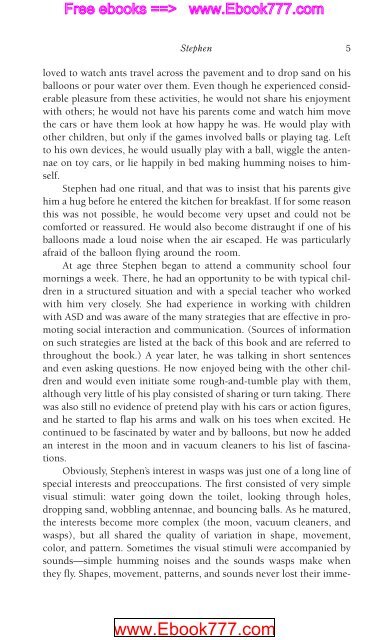978-1572305441
autism
autism
You also want an ePaper? Increase the reach of your titles
YUMPU automatically turns print PDFs into web optimized ePapers that Google loves.
Free ebooks ==> www.Ebook777.com<br />
www.Ebook777.com<br />
Stephen 5<br />
loved to watch ants travel across the pavement and to drop sand on his<br />
balloons or pour water over them. Even though he experienced considerable<br />
pleasure from these activities, he would not share his enjoyment<br />
with others; he would not have his parents come and watch him move<br />
the cars or have them look at how happy he was. He would play with<br />
other children, but only if the games involved balls or playing tag. Left<br />
to his own devices, he would usually play with a ball, wiggle the antennae<br />
on toy cars, or lie happily in bed making humming noises to himself.<br />
Stephen had one ritual, and that was to insist that his parents give<br />
him a hug before he entered the kitchen for breakfast. If for some reason<br />
this was not possible, he would become very upset and could not be<br />
comforted or reassured. He would also become distraught if one of his<br />
balloons made a loud noise when the air escaped. He was particularly<br />
afraid of the balloon flying around the room.<br />
At age three Stephen began to attend a community school four<br />
mornings a week. There, he had an opportunity to be with typical children<br />
in a structured situation and with a special teacher who worked<br />
with him very closely. She had experience in working with children<br />
with ASD and was aware of the many strategies that are effective in promoting<br />
social interaction and communication. (Sources of information<br />
on such strategies are listed at the back of this book and are referred to<br />
throughout the book.) A year later, he was talking in short sentences<br />
and even asking questions. He now enjoyed being with the other children<br />
and would even initiate some rough-and-tumble play with them,<br />
although very little of his play consisted of sharing or turn taking. There<br />
was also still no evidence of pretend play with his cars or action figures,<br />
and he started to flap his arms and walk on his toes when excited. He<br />
continued to be fascinated by water and by balloons, but now he added<br />
an interest in the moon and in vacuum cleaners to his list of fascinations.<br />
Obviously, Stephen’s interest in wasps was just one of a long line of<br />
special interests and preoccupations. The first consisted of very simple<br />
visual stimuli: water going down the toilet, looking through holes,<br />
dropping sand, wobbling antennae, and bouncing balls. As he matured,<br />
the interests become more complex (the moon, vacuum cleaners, and<br />
wasps), but all shared the quality of variation in shape, movement,<br />
color, and pattern. Sometimes the visual stimuli were accompanied by<br />
sounds—simple humming noises and the sounds wasps make when<br />
they fly. Shapes, movement, patterns, and sounds never lost their imme-



